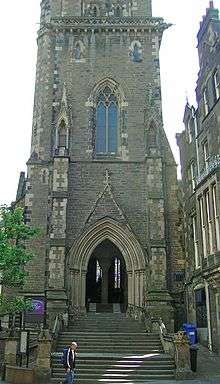St Paul's Cathedral, Dundee
| Cathedral Church of Saint Paul | |
|---|---|
 | |
| Denomination | Scottish Episcopal Church |
| Churchmanship | Broad Church |
| Website | www.saintpaulscathedral.net |
| History | |
| Dedication | St Paul |
| Administration | |
| Diocese | Brechin |
| Clergy | |
| Bishop(s) | Right Rev Dr Nigel Peyton |
| Provost | Very Rev Jeremy Auld |
St Paul's Cathedral is an Anglican cathedral in the city of Dundee, Scotland. It is the Cathedral and administrative centre of the Diocese of Brechin in the Scottish Episcopal Church.
Castle
It is built on the site of the medieval seat of power in the area, the castle which formerly stood on the site had been besieged by the armies of William Wallace, Andrew de Moray and later by Robert the Bruce during the Wars of Scottish Independence. The stronghold was destroyed during the Wars of the Three Kingdoms. A small portion of the castle still remains within the Cathedral grounds. During the building of modern offices on Exchange Street behind the cathedral workers discovered remains of the castle in the form of a crypt-like structure underground. It is thought that the site may have borne fortifications from as far back as 80 AD.
Church
In 1847, Alexander Penrose Forbes was elected new Bishop of Brechin and chose to make Dundee his permanent residence.
At the time of Bishop Forbes' arrival, St Paul's Chapel met in rooms in nearby Castle Street, which Forbes considered to be dreary and "unworthy of the worship of the Almighty". Thus, he "urged his people to take on the holy work of building, to the glory of God, a stately church", a place which would offer refuge to the many poor that lived in the surrounding tenements.
The foundation stone of the Cathedral was laid on 21 July 1853 and it was completed in 1855.[1] It was designed by George Gilbert Scott and is in the style of the Middle or Decorated period of Gothic architecture.
The total cost of the building exceeded £14,000, and ten years passed before the congregation could pay off all the debts incurred. The church was dedicated on All Saints Day, 1 November 1865.[1]
St Paul's was raised to Cathedral status in 1905 and is now a category A listed building.
References
External links
Coordinates: 56°27′40″N 2°58′5″W / 56.46111°N 2.96806°W